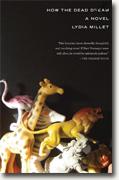How the Dead Dream
Lydia Millet
book reviews:
· general fiction
· chick lit/romance
· sci-fi/fantasy
· graphic novels
· nonfiction
· audio books
· author interviews
· children's books @
curledupkids.com
· DVD reviews @
curledupdvd.com
newsletter
win books
buy online
links
home
for authors
& publishers
for reviewers

 |
How the Dead Dream Lydia Millet Mariner Paperback 256 pages September 2009 |
|
Never before have I encountered a writer like Lydia Millet, a woman who makes every page scintillate with poetry that bypasses the realm of common speech and communicates directly with a reader’s heart and soul. It may be hyperbolic to call her writing perfect, but no other word comes to mind.
From his childhood through his college years, T. becomes a shrewd entrepreneur with a fetish for money, earning it through honest and semi-honest means at the expense of any personal or emotional development. Eschewing any typical passions and relationships of any kind, he devotes himself wholeheartedly to the acquisition of wealth. During his college years, he becomes especially useful to his wealthy, drunken, and bestial frat brothers as a smooth operator whose quiet abstention from drink, drugs, women, and seemingly fun of any kind, allows him to clean up their messes. One can practically hear Millet cackling beneath her velvet-smooth prose in this section; her satire is smart, making up for a certain lack or originality with painful barbs. As T. moves on to easily become a millionaire real estate developer, he finds himself in a rut as the man to whom all things come easily. His deadened stupor soon ends after he is faced with two painful burials: a coyote that he accidentally kills on a highway and his girlfriend, whose life seemed to have little effect on him but whose death deals a devastating blow. Unable to maintain his distance from the world around him, his life crumbles, forcing him to keep up his veneer of granite stoicism for his clients while coming to terms with his newly discovered moral responsibilities. Confronting death for the first time, T. understands his debt to life and charges himself with preserving it. The few humans in his life worth any of our sympathies become his new charges (such as his mother, who is painfully succumbing to dementia), but animals become his real project as he travels around the country freeing them from zoos where they are maltreated. The old T. withers away as all the compassion and moral responsibility he lacked earlier in life blooms into his new personality. Equally as startling is how Millet shifts the tone of the novel from barbed satire and grief to a depiction of our species and our planet in a downward spiral beyond the reach of redemption. She isn’t apocalyptic, but she’s close. It’s up to the reader to decide if T.’s newfound moral revelations are too little too late, but that we’re able to empathize with him at all—let alone that he becomes a beautiful tragic hero—is a testament to how much power Millet has over us. T.’s union with the animal world is a simple, poignant reminder of that all-too-familiar sentiment: all life is connected, and our ignorance and cruelty will come back to bite us. Millet strips all the gloppy sentimentalism away, restating this old theme in a vibrant and urgent way. But she almost goes too far. It’s all too easy to anthropomorphize animals to gain our sympathies, and Millet at times is guilty. To do so cheapens her message; we shouldn’t have to make animals into little people to make them important. It’s their inhumanity that we must come to love, cherish, and see in ourselves. Imposing ourselves on them is what got us all into this mess in the first place. There are also times when the environmentalist tone is a little over the top. But while Millet does believe in subtlety, she does not believe in delicacy: this preaching had to come at some point, but it is short and to the point. How the Dead Dream Originally published on Curled Up With A Good Book at www.curledup.com. © Max Falkowitz, 2010 |
| Also by Lydia Millet: |
|
|
|
 Click here to learn more about this month's sponsor! |
|
| fiction · sf/f · comic books · nonfiction · audio newsletter · free book contest · buy books online review index · links · · authors & publishers reviewers |
|
| site by ELBO Computing Resources, Inc. | |
 In
In